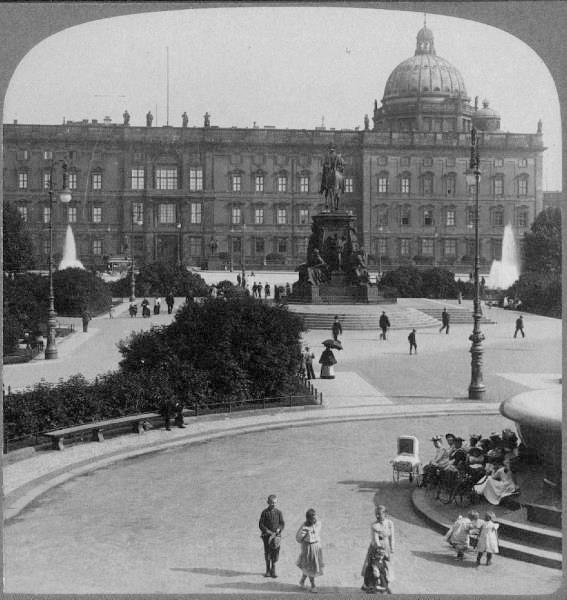
Specific German Parks

Figure 1-- This stereoviewcard shows public spaces in front of the Kaiser's Berlin palace. Here we see people and children enjoying themselves before World War I, probably about 1903. It was called the Berliner Schloss or Stadtschloss as well as the Berlin City Palace andlocated in the center of the city on the Museum Island, opposite the Lustgarten park. It was a royal/imperial palace and the main residence of the Electors of Brandenburg, the Kings of Prussia, and the German Emperors. Royal palaces were not high on the historical interest of the Communist East German (DDR) Government. The Communists demolished the palace (1950s). After Unification, the Government decided to rebuild it.
|
|
We do not have much information on specific German parks. We believe that is because we are not as familiar with Germany as some other countries such as America, England, and France with a number of internationally recognized parks. Hopefully our German readers will tell us something about German parks. We note public spaces in front of the Kaiser's Berlin palace with people and children enjoying themselves before World War I (figure 1).
It was called the Berliner Schloss or Stadtschloss as well as the Berlin City Palace andlocated in the center of the city on the Museum Island, opposite the Lustgarten park. It was a royal/imperial palace and the main residence of the Electors of Brandenburg, the Kings of Prussia, and the German Emperors. Royal palaces were not high on the historical interest of the Communist East German (DDR) Government. The Communists demolished the palace (1950s). After Unification, the Government decided to rebuild it. On the previous page is a scene from the Volkspark Friedrichshain in Berlin. There is a large lake in the southwestern quadrant of Berlin--Wannsee. It is not a park itself, but is widely used by Berliners for recreation. The Potsdam palaces there of the former German imperial family. A major World war II Allied conference was held there (1945). Wannsee lake itself is the most important swimming and boating recreation area for Berliners, including isolated West Berliners during the Cold War. The Strandbad Wannsee is an open-air lido with one of the longest inland beaches in all Europe. A well known park in Germany is the Niederwalddenkmal a kind of national monument near Rüdesheim am Rhein. It commemorates the unification of Germany under the Prussian monarchy. This occurred with Wilhemn I was crowne kaiser in the Hall of Mirrors at Versailles. But the Germans could hardly build their nationl momument near Paris. So the chose a magnificent site on the high ground verlooking the Rhine River at the edge of a dense forrest--the Niederwald. The connection is that it was in the dorest whre Armenius defeated the Roman legions, often seen as the birth of the German nation. And the site overlooks the Rhine, commonly see as geographic gardian of the German nation a expressed in the Watch on the Rhine.
HBC

Navigate the Boys' Historical Clothing Web Site:
[Return to Main German parks page]
[Return to Main park outing national page]
[Return to Main 20th century family page]
[Introduction]
[Activities]
[Biographies]
[Chronology]
[Cloth and textiles]
[Clothing styles]
[Countries]
[Topics]
[Bibliographies]
[Contributions]
[FAQs]
[Glossaries]
[Images]
[Links]
[Registration]
[Tools]
[Boys' Clothing Home]
Navigate the Boys' Historical Clothing Web Site:
[Sailor suits]
[Sailor hats]
[Buster Brown suits]
[Eton suits]
[Rompers]
[Tunics]
[Smocks]
[Pinafores]
Created: 3:31 AM 1/31/2019
Last updated: 3:31 AM 1/31/2019



